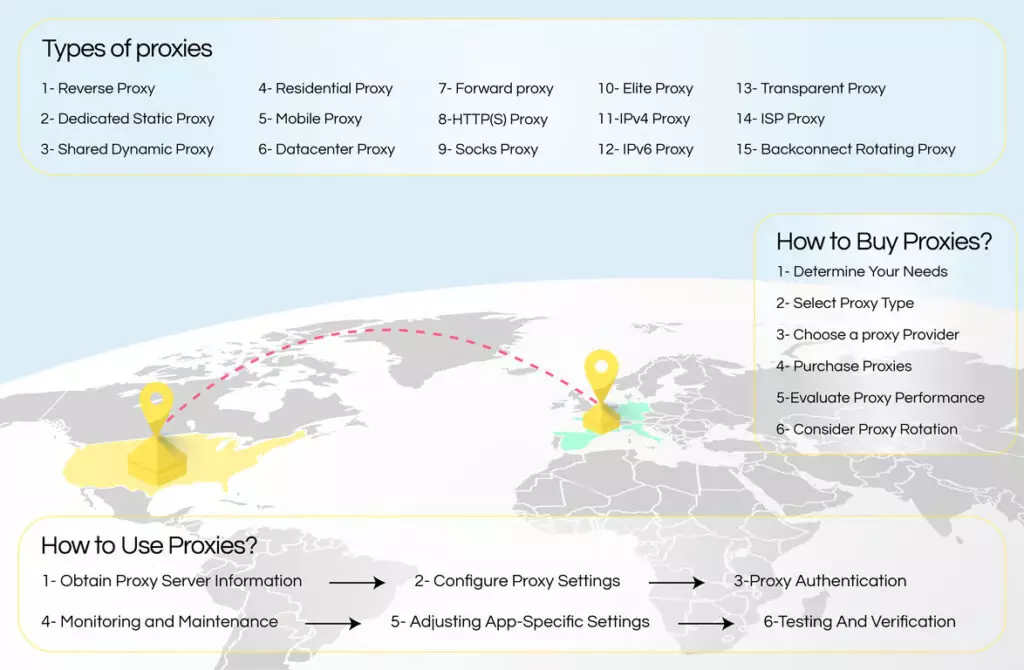
Abed Elezz
Share
Whether you’re driven by the demand for security and privacy, the enhancement of your online operations, or simply curious about proxies, then you’ve definitely come to the right place.
The emergence of proxies has granted individuals and businesses an indispensable tool to overcoming the increasing web limitations, thus democratizing your online experience.
In this comprehensive guide, we will delve into the world of proxies and explore their definition, how they work, and the different types available. Get ready to uncover the benefits of using proxies and gain a comprehensive understanding of this essential tool in today’s digital landscape. Let’s get started!
The term “proxy” or “proxies” may be interpreted differently according to the context used. For example, in the e-commerce industry, the term “proxy” is used in “proxy purchase,” which indicates the process of someone purchasing a product on behalf of someone else.
Meanwhile, in the legal sector, it refers to a person authorized to act on someone’s behalf. In the corporate setting, it indicates the term “proxy vote,” which refers to the authority given to someone to vote in the representation of someone else. If you noticed, in all contexts, the term proxy is a middleman acting on behalf of a client.
So, what’s the deal with proxies in terms of computer networking, and what exactly is a web proxy? Well, let’s break it down for you. A proxy is a server that acts as an intermediary between your device and the Internet. When you connect to the Internet through a proxy, it masks your actual IP address and sends requests on your behalf, much like the different scenarios mentioned above.
In simpler terms, it serves as a middleman between you and the websites you visit. It provides a protective barrier, allowing you to access online content while maintaining your privacy and security.
In the realm of computer networks, we understood that proxies play a vital role as intermediary servers. You may even consider them smart mediators, providing you with a secure connection to the broader Internet space. Their job is to ensure not only a smooth online experience but also a secure one for online users.
When you use a proxy server, it will intercept and handle all Internet traffic. Therefore, as the client, all your web requests are routed through the proxy server before reaching the target destination.
This detour of requests offers a powerful advantage since the websites visited will see the proxy server’s IP address as your own. Thus increasing your privacy by creating a private network.
To complete a proxy’s entire network process, the client, proxy server, and target server will undergo the following steps:
Once the network cycle is deemed successful, the client will have created a secure Internet connection using a proxy server, thus entering a world of limitless web possibilities.
However, it’s essential to keep in mind that different types of proxies may operate with subtle differences.
These operational differences may also lie in how the user uses these proxies. But what are the different types of proxies available? And how do they differ from one another?
With a wide array of proxy types available, understanding their differences allows you to choose the most suitable proxy server for your specific use case.
Whether it’s a residential proxy, datacenter, or mobile proxy – each type serves its strengths for the best-suited applications.
A residential proxy, you can judge by its name, utilizes legitimate residential IP addresses designated by an Internet Service Provider (ISP) – meaning that it assigns you a real IP address of a home network. Therefore giving the appearance that you are a residential browser.
The specific IP assigned depends on the proxy provider and the location of the proxy server.
More likely than not, a residential proxy offers a wide pool of IPs, which is why many prefer it for large-scale web scraping and automation projects.
A mobile proxy utilizes a cell phone IP address assigned by a mobile network operator (MNO) or a mobile carrier. Thus allowing your Internet traffic to appear from a mobile device’s origins.
The main difference between a mobile proxy and a residential proxy is their leverage in utilizing cellular network connections, such as 3G, 4G, and 5G.
Ultimately giving the advantage of accessing more web resources and content accessible by mobile devices.
A datacenter proxy is not associated with Internet Service Providers or Mobile Network Operators, as it’s typically hosted in data centers.
They’re mostly used for server-to-server communications, lightweight scraping, and automation tasks.
Although a datacenter proxy is generally faster than a residential proxy, it tends to be easily detected and blocked by websites – making them an unpreferred choice by proxy users.
HTTP proxies handle HTTP requests and responses. They act as a transmitter between the client (typically a web browser) and the target server and are mainly used for browsing activities.
They utilize different types of IP addresses, such as residential, mobile, or datacenter, depending on the type of proxy you’re using and the proxy provider.
SOCKS proxies are considered more versatile than HTTP proxies, as they handle various network protocols beyond HTTP, such as FTP (File Transfer Protocol), SMTP (Simple Mail Transfer Protocol), and many others.
Similar to HTTP proxies, they assign you an IP address depending on the proxy server and proxy you’re using.
They’re suitable for a range of applications, including online gaming, remote server management, or remote network access.
IT professionals and businesses utilize SOCKS proxies for managing a network’s infrastructure and secure communication channels.
A transparent proxy doesn’t modify your requests or response headers. Instead, it’s typically utilized for caching frequently requested content, speeding up browsing, and enforcing content filters without requiring client-side configurations.
A forward proxy, also known as a client-side proxy, is positioned between the client and the web to retrieve resources from the Internet.
The forward proxy is mainly used in corporate networks to control employees’ Internet access, enforce content filters, and enhance security.
Unlike a forward proxy, a reverse proxy, known as a server-side proxy, is positioned between the web and backend servers and communicates with the client on their behalf. It’s mainly used for protecting private networks from external threats, such as denial-of-service attacks and malware.
A dedicated static proxy is a type of proxy server that provides you with a fixed or dedicated IP address and is typically assigned to a single client.
It offers you sole access and control over the proxy’s resources, allowing you to customize the proxy settings for any specific use case and removing the risk of other users potentially using the same IP address.
Unlike dynamic proxies, which change IP addresses periodically, a dedicated proxy offers a consistent and stable IP address that remains the same every time you connect to it.
In a shared dynamic proxy setup, multiple users share a pool of dynamic IP addresses simultaneously. These IP addresses are rotated automatically at regular intervals but shared among all users.
This means that different users may be assigned the same IP address at different times, and the IP addresses change on a schedule set by the proxy provider.
Its performance varies as the available bandwidth is divided among several users and tends to offer limited control.
Similar to the shared proxy, a backconnect rotating proxy provides you with a dynamic set of IP addresses.
It assigns clients a dedicated “gateway” IP address, which serves as the entry point to the proxy network.
Behind this gateway IP is a pool of rotating or “backconnecting” IP addresses, often changing automatically or manually set intervals.
Unlike the shared proxy, this type of proxy offers you more control over your gateway IP address and the proxy’s rotating capabilities.
An IPv4 proxy operates on the Internet Protocol version 4 (IPv4) network. IPv4 is the fourth version of the Internet protocol and is the most widely used for routing data packets on the Internet.
It allows you to route your web requests through the proxy server, which will have its own IPv4 address consisting of 15 digits.
An IPv6 proxy operates on the Internet Protocol version 6 (IPv6) network, destined to replace the older IPv4 due to the depletion of its available IP addresses.
IPv6 proxies work similarly to IPv4, but use longer IP addresses of 32 digits, offering more scalability.
An ISP proxy, also known as an ISP-level proxy, is a proxy server operated and controlled by an Internet Service Provider.
It is typically deployed at the ISP’s network level and performs various functions, such as caching web content, optimizing network traffic, and enhancing security.
An elite proxy, also known as a high-anonymity proxy, is a type of proxy server that provides the highest level of anonymity and security for users.
When you connect to the Internet through an elite proxy, your real IP address and identity are effectively concealed, making it extremely difficult for websites and online services to determine your true location or trace your online activities back to you.
Utilizing proxies on a business level, even on a personal level, will provide you with robust benefits that will ultimately enhance your online experience.
However, no solution is without its set of limitations. In this section, we will explore all the perks of employing the impactful tool that is proxies and the drawbacks that follow.
Now that we’ve discussed the various advantages and disadvantages of proxies, you should have a better understanding of how they work and what they can do for your network. Remember to weigh the pros and cons before setting up a proxy server for your business.
Proxies and Virtual Private Networks (VPNs) are distinct tools that cater to different technical requirements. One key difference is the scope of traffic handling. Proxies intercept specific protocol types, such as HTTP or SOCKS, and focus on optimizing the performance of the particular network traffic.
Therefore, users can configure proxies based on their use case, directing only relevant traffic through the proxy server. Ultimately, users will leverage the proxy’s faster speeds and reduced latency by routing only relevant traffic.
On the other hand, VPNs have higher encryption capabilities due to their creation of an encrypted tunnel between the client and the remote VPN server where all internet traffic, regardless of the protocol, is routed through.
Therefore, all online activities such as web browsing, email, file sharing, and other activities benefit from the VPN’s protection and encryption. However, since all Internet traffic is routed through the VPN tunnel going through a comprehensive encryption and decryption process, users may experience slower speeds and higher latency.
Proxies also offer an advantage when users require multiple IP addresses for different tasks. Businesses engaged in data collection, market research, or the optimization of marketing tasks leverage proxies to distribute requests across various IP addresses to prevent detection or blocking.
The IP rotation capability is vital for maintaining data accuracy and bypassing web limitations – a feature not readily available with standard VPN configurations.
In essence, proxies offer technical advantages in terms of specialized traffic handling, targeted application routing, and IP rotation. Their streamlined nature and focus on specific tasks make them an efficient choice for users seeking enhanced performance and optimization in their online and business activities.
Proxy tunneling protocols are communication protocols used to secure data as it routes through a network, typically between a client and a server.
HTTP and SOCKS are a proxy network’s most commonly utilized tunneling protocols. When it comes to determining which protocol is more secure, it’s essential to understand its characteristics.
SOCKS is a protocol that supports multiple versions, with the most popular being SOCKS4 and SOCKS5. Each version varies in their support of different protocols for proxy authentication and how they transfer data.
Here’s a brief overview of the protocols they support:
The choice between SOCKS4 and SOCKS5 depends on your specific requirements. If you need support for UDP traffic or advanced authentication methods, SOCKS5 is the better choice.
However, if you have a simple use case that only involves TCP traffic and doesn’t require authentication, SOCKS4 may suffice.
On the other hand, HTTP tunneling is a less versatile protocol and is often known as a web protocol.
They are specifically designed to handle web content and operate at the application level.
Here’s how it works and its key characteristics:
In terms of security, SOCKS proxies have the upper hand due to their protocol-agnostic nature and the ability to support encryption. When configured correctly, they can provide a high level of privacy and security for a wide range of internet activities.
While suitable for specific use cases like web browsing, HTTP proxies may not offer the same level of security, especially for non-web traffic.
Additionally, because HTTP proxies are often associated with web-related activities, they may be more susceptible to detection and blocking by websites and network administrators.
Ultimately, the choice between HTTP and SOCKS proxies depends on your specific needs. Regardless of your choice, it’s essential to configure and use proxies correctly to ensure security and privacy.
If you already have an idea of what you’re using the proxies for and the requirements you need, then buying a proxy is a straightforward procedure. If not, here are some steps to follow that aid in the process:
Now that we’ve gone through the steps of purchasing a proxy, it’s time to get the hang of how you’ll actually put them to use. So, what’s the process when it comes to using a proxy?
Using a proxy involves configuring a device’s network settings, such as a computer or a smartphone, to route its internet traffic through a proxy server.
This process requires specifying the proxy server’s IP address or hostname and the corresponding port number.
Once the proxy settings are correctly configured, the device sends its network requests to the proxy server instead of directly to the target server.
Here’s a step-by-step breakdown of how you can typically use a proxy:
It’s important to note that using a proxy may vary slightly depending on the operating system and device used. And different applications may have specific proxy settings that need to be configured separately.
As digital boundaries are expanding, and privacy concerns are on the rise, proxies offer a gateway to a safer and more personalized online experience.
So whether you’re looking to enhance your privacy, an aspiring data miner, or just curious about the digital world’s inner workings, this guide has equipped you with the knowledge you need to navigate the proxy realm.
However, keep in mind that while proxies come with great potential, it’s your understanding and responsible usage that will truly unleash their potential.
About the author
Abed Elezz
Save Up To 90% on Your Proxies
Discover the world’s first distributed proxy network, which guarantees the best IP quality, reliability and price.
Start for Free! Start for Free! Start for Free! Start for Free! Start for Free!
Pricing
Company
Products
Resources
Docs
United States
1515 Market Street, Suite 1200 – #822, Philadelphia PA 19102
United Kingdom
85 Great Portland St, London W1W 7LT
All Proxidize hardware is assembled and shipped from the United States and the Netherlands.
© 2025 Proxidize | All Rights Reserved
Discount Applied Successfully!
Your savings have been added to the cart.
Looking to get started with Proxidize? Our team is here to help.
“Proxidize has been instrumental in helping our business grow faster than ever over the last 12 months. In short, Proxidize has empowered us to have control over every part of our business, which should be the goal of any successful company.”

By submitting this form, you consent to receive marketing communications from Proxidize regarding our products, services, and events. Your information will be processed in accordance with our Privacy Policy. You may unsubscribe at any time.